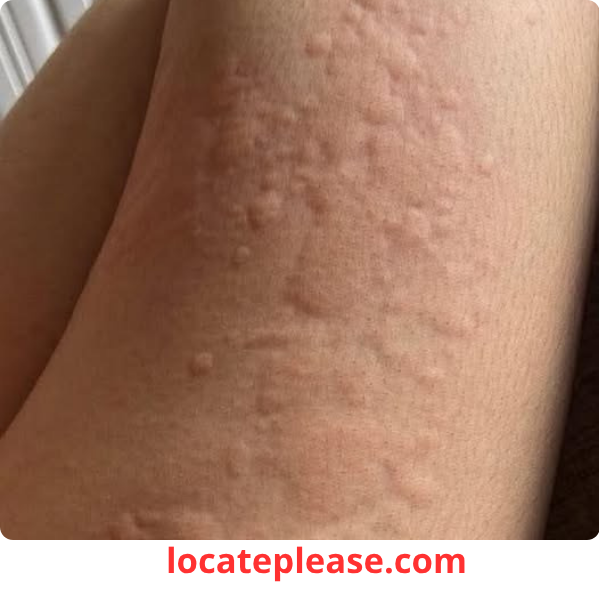It started with a small patch of redness on her arm.
Then came the tingling, the prickling, the relentless itch — first on her legs, then her back, then her arms. Within days, her entire body was on fire with discomfort.
She chalked it up to a seasonal allergy or a reaction to a new laundry detergent.
But antihistamines didn’t help.
The rash came and went without warning.
And the itching? It got worse at night — so bad it disrupted her sleep, her mood, her life.
This wasn’t just an allergy.
It was something far more complex — and far more common than most people realize.
She was suffering from hives — and her story is a powerful reminder that not all skin problems are what they seem.
What Are Hives? More Than Just a Rash
Hives — medically known as urticaria — are raised, red, intensely itchy welts that appear suddenly on the skin. They can be:
- As small as a pencil eraser
- Or grow into large, swollen patches
- They often change shape, move around the body, and disappear and reappear within hours
While hives are sometimes triggered by allergies to food, medication, or insect bites, they can also be caused by:
- Stress
- Infections
- Temperature changes (hot showers, cold air)
- Autoimmune reactions
- Hormonal fluctuations
- Chronic illness
And in up to 50% of chronic cases, the cause remains unknown.
How Hives Are Different From a Simple Allergy
|
Reaction to a known trigger (e.g., peanuts, pollen)
|
Can appear without a clear cause
|
|
Symptoms subside once the allergen is removed
|
May last for weeks or months
|
|
Usually localized
|
Often spreads across the body
|
|
Resolves quickly with antihistamines
|
May require long-term management
|
In this woman’s case, there was no clear allergen — no new soap, no shellfish, no bee sting.
Her immune system was overreacting for reasons even her doctors couldn’t immediately pinpoint.
Recognizing the Signs of Hives
If you or a loved one is experiencing unexplained itching, look for these key symptoms:
- Red or skin-colored welts that appear and fade within 24 hours
- Intense itching, burning, or stinging
- Swelling that migrates from one area to another
- Worsening at night or after stress, heat, or physical activity
- Recurrent episodes lasting six weeks or more (chronic hives)
⚠️ Seek immediate medical attention if hives are accompanied by:
- Swelling of the face, lips, or tongue
- Difficulty breathing
- Dizziness or fainting
These could be signs of anaphylaxis — a life-threatening reaction.
Natural Relief: Soothe the Itch the Gentle Way
While medical treatment (like antihistamines or corticosteroids) is essential for managing hives, natural remedies can help soothe symptoms and support healing.
🌿 Oatmeal & Honey Soothing Paste
A gentle, anti-inflammatory remedy to calm irritated skin.
Ingredients:
- 2 tbsp ground oats (colloidal oatmeal)
- 1 cup cold water
- 1 tbsp raw honey (antibacterial and moisturizing)
- A few drops of chamomile essential oil (optional, for added calm)
How to Use:
- Mix oats and water into a smooth paste.
- Stir in honey and chamomile oil.
- Apply to affected areas and leave on for 15–20 minutes.
- Rinse with cool water and pat dry.
✅ Why it works:
- Oats reduce inflammation and restore the skin barrier
- Honey soothes and fights bacteria
- Chamomile calms nerve irritation and redness
💡 Alternative: Take a colloidal oatmeal bath for full-body relief.
Tips to Prevent Future Outbreaks
Even when the cause isn’t clear, you can reduce flare-ups by: ✅ Tracking triggers — keep a symptom diary (food, stress, weather, sleep)
✅ Wearing loose, breathable clothing — cotton reduces irritation
✅ Using fragrance-free, hypoallergenic skincare products
✅ Avoiding hot showers and saunas — heat can trigger hives
✅ Managing stress — meditation, yoga, and deep breathing can help
✅ Staying hydrated — healthy skin is more resilient
When to See a Doctor
Hives that last more than six weeks are considered chronic — and require medical evaluation.
A dermatologist or allergist may recommend:
- Blood tests
- Allergy testing
- Autoimmune screening
- Prescription medications (like H2 blockers, leukotriene inhibitors, or biologics)
For many, chronic hives are linked to underlying immune dysfunction — not just surface-level allergies.
Final Thoughts: Listen to Your Body — It’s Trying to Tell You Something
This woman’s journey from “just an itch” to a diagnosis of chronic urticaria is more common than you think.
Skin symptoms are often dismissed as minor — but they can be early signals of deeper imbalances in the body.
The good news?
With the right diagnosis, treatment, and self-care, hives can be managed — and quality of life restored.
So if you’re dealing with unexplained itching, redness, or welts: 👉 Don’t ignore it.
👉 Don’t just scratch it.
👉 Investigate it.
Because sometimes, the most ordinary symptom can be hiding an extraordinary story.
Your skin isn’t just a surface — it’s a mirror of your health. Listen closely.










